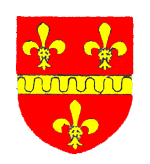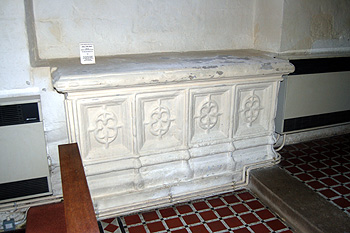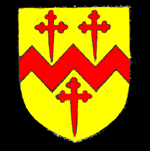The Manor of Eaton alias Eaton Bray
Volume III of The Victoria County History for Bedfordshire was published in 1912. It has a history of the manor as set out below. It seems reasonable to assume that this manor was simply the continuation of the holding of twelve hides, one virgate of Bishop Odo of Bayeux, recorded in the Domesday Book of 1086.
When Odo organised a rebellion against William II (1087-1100) in 1088 in favour of William's older brother Robert Curthose, Duke of Normandy, his estates were seized by the Crown. King Henry II (1154-1189) leased the manor to Osbert Martel for £20 per annum and his name appears as the Lord of the Manor in the royal Pipe Rolls between 1166 and 1173, at which date the lease of the manor was transferred to Adulf de Braci who held it until at least 1179 at the same rent. The manor was later in the possession of Henry II's widow Queen Eleanor who granted it to her butler Engelram. He granted half the manor to the Abbey of Fontévrault in France (where Henry II had been buried) and Queen Eleanor approved the grant.

The Cantlowe family coat of arms
Queen Eleanor died in 1204 and her son King John (1199-1216) granted the manor in the following year to William de Cantlowe in exchange for 300 marks (a mark was two thirds of a pound sterling) and Cantlowe's manor at Cockeswall. Cantlowe was the husband of Mascelin, daughter of Adulf de Braci. When the nuns of Fontévrault claimed half the manor William bought them off by assigning Thrempit Mill with accompanying fish ponds to them. Cantlowe fought for King John against his barons.
A new royal charter by Henry III (1216-1272) in 1227 confirmed the manor to Cantlowe and he held it until his death in 1254. He built himself a castle at Eaton Bray in 1221. Cantlowe was succeeded by his son Geoffrey but when he died in 1273 he left only two sisters - Millicent, the wife of Eudo la Zouche and Joan, widow of Henry de Hastings. Eaton Manor was assigned to Millicent and on her death in 1298 it passed to her son William la Zouche, who also held the manors of Whipsnade, Houghton Regis and Totternhoe. He settled Eaton on his second son William but he released his claim in 1333 and his father then settled it on the son of his eldest son Eudo, another William.

The coat of arms of the Lords Zouche of Haringworth
This William was ennobled as Lord Zouche of Haringworth and on his death in 1382 the manor passed to his son William, one of the "evil councillors" of Richard II (1377-1399). He died in 1396 and his son was active in the Hundred Years' War against France under Henry V (1413-1422), being Lieutenant of Calais in 1413. He died in 1415 and three more generations of William la Zouches followed him as Lord of the Manor. John la Zouche, son of the third of these Williams fought with Richard III (1483-1485) at Bosworth Field. He survived the battle but was attainted for treason by the usurper Henry VII (1485-1509) and his estates were confiscated.

The Bray family coat of arms
In 1490 Eaton Manor was granted by King Henry to Worcestershire man Sir Reginald Bray who had fought on his side at Bosworth and became the king's chief minister as High Treasurer and Chancellor of the Duchy of Lancaster. In 1496 John le Zouche's attainder was reversed by Bray kept his Bedfordshire lands on paying him 1,010 marks. He was the architect of both Saint George's Chapel, Windsor [Berkshire] and King Henry VII's chapel in Westminster Abbey. He died in the same year as his king but, unlike him, childless and Edmund, his nephew, inherited Eaton Bray.

Tomb of Lady Jane Brereton July 2012
Edmund was created 1st Baron Bray in 1529 by Henry VIII (1509-1547). He was Sheriff of Bedfordshire in 1514 and 1515 and died in 1539 having settled Eaton Bray on his son John. The 1st Baron was buried in Chelsea, like his father, but his widow Jane, who later married Sir Urian Brereton, was buried in Eaton Bray and her brass and tomb may be seen in the church.

Brass of Lady Jane Brereton July 2012
John, the 2nd Baron died of wounds received at the Battle of Saint-Quentin in 1557 where the Spanish defeated the French. As Philip II of Spain was also King of England (being married to Henry VIII's daughter Mary I (1553-1558)), Bray was fighting on the Spanish side. As he had no children the barony died with him but his brother Edward succeeded to the barony for a year before his own death when his son Edward succeeded and settled the manor on his wife Elizabeth in 1560 but six years later he alienated it for 2,000 marks to Edmund Bray, who sold the estate to Walter Sandys in 1574. By 1577 trustees for Miles Sandys had acquired the manor and ten years later he settled it on his son Edwin.

The Sandys family coat of arms
Sir Edwin Sandys settled the manor on his kinswoman Elizabeth who was also his wife. Sir Edwin died in 1608 leaving a son, William who, in 1622, settled it on trustees but the following year he and his brothers Miles and Henry quitclaimed the manor to John Huxley.

The Huxley family coat of arms
Huxley’s son, another John, was knighted at the Restoration of Charles II (1660-1685) and died in 1675. The Huxleys remained lords of the manor until the mid 18th century – Thomas Huxley left the manor to his brother-in-law Isaac Hughes in trust for sale in his will of 1742. The manor was bought by the Archbishop of Canterbury, John Potter. The Potters then owned the manor until 1763 when it was sold to Lord Mayor of London, William Beckford and that family held it into the 19th century.
In 1854 the manor was in the hands of Anne, widow of Arthur Macnamara. She died in 1875 when the manor passed to her son Arthur until 1906 when it passed to his twin brother John who held it until the time the Victoria County History was published. A succession of Law of Property Acts in the 1920s extinguished all manorial incidents, courts and copyhold tenure of land. This effectively abolished manors in all but name. In 1936 the two Ladies of the Manor were stated to be Winifred May Wallace of Poplar Farm, spinster and Harriet Frankham Gray, wife of Ernest Gray of Comp Farm by conveyance of 2nd June 1931 from William Edmund Wallace of Poplar Farm.